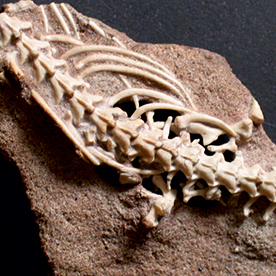EL ÁREA DE PALEONTOLOGÍA DE LA FUNDACIÓN AZARA
DOI:
https://doi.org/10.5710/PEAPA.23.06.2021.351Palabras clave:
Dinosaurios, Cocodrilos, Lepidosaurios, Cretácico, Sudamérica, Icnología, La Buitrera, Buenos AiresResumen
El Área de Paleontología de la Fundación Azara funciona en la Universidad Maimónides. En 17 años se ha afianzado con solidez en las publicaciones, los encuentros de colegas y en los medios. En la faceta de exploración ha aportado más de 10 nuevas localidades paleoherpetológicas, algunas tan importantes como el Área Paleontológica de La Buitrera, La Bonita, La Escondida, El Pueblito y el campo de Violante, todas en la provincia de Río Negro, y Bajada Colorada en la provincia de Neuquén. Fuera del país ha aportado las nuevas localidades icnológicas de Tunasniyoj y Ruditayoj (Bolivia) y explorado por primera vez la localidad de Yamana en Ecuador. En la etapa de investigación se han aportado cerca de 50 nuevas especies paleoherpetológicas y visiones novedosas como la existencia de serpientes 70 millones de años más antiguas de las conocidas, la relación entre esfenodontes jurásicos al sur del desierto pangéico, las sucesiones en las faunas de dinosaurios sudamericanos, la presencia de picos y mandíbulas cuadradas entre los titanosaurios y la extinción de los terópodos carcarodontosáuridos y su coincidencia con la extinción de los saurópodos rebaquisáuridos. Desde la formación de recursos humanos se han concretado con temas propios unas 10 tesis doctorales y otras tantas tesinas formando un grupo de investigadores hoy distribuido por el país. Finalmente, desde la divulgación, se han llevado a cabo series de ficción, programas informativos y publicado una decena de libros además de iniciado o retomado publicaciones seriadas sobre temas de ciencias naturales.
Referencias
Agnolín, F. y Novas, F. E. (2011). Unenlagiid theropods: are they members of the Dromaeosauridae? Anais da Academia Brasileira de Ciencias, 83(1), 117–162.
Apesteguía, S. (2004). Bonitasaura salgadoi: A beaked sauropod in the Late Cretaceous of Gondwana. Naturwissenschaften, 91(10), 493–497.
Apesteguía, S. (2005a). A Late Campanian sphenodontid (Reptilia, Diapsida) from northern Patagonia. Comptes Rendus Palevol, 4(8), 663–669.
Apesteguía, S. (2005b). Dinosaurios: sur, meteorito y después. En D. Golombek y M. De Ambrosio (Eds.), Hoy las ciencias adelantan que es una barbaridad (pp. 58–73). Libros del Rojas.
Apesteguía, S. (2005c). El tiempo está a favor de los pequeños: La Buitrera, un yacimiento del norte patagónico. Encrucijadas, 30, 74–81.
Apesteguía, S. (2007). La evolución de los lepidosaurios. Investigación y Ciencia, 367, 54–63.
Apesteguía, S. (2012). Extinciones en tiempos geológicos. En G. Porini (Ed.), Especies Amenzadas (pp. 29–44). Vázquez Massini Editores.
Apesteguía, S. (2013). Extinctum. Si muove: Revista de divulgación del Planetario de la Ciudad de Buenos Aires, 6, 29–36.
Apesteguía, S. (2014). Paleontología en Cerro Policía. AZARA, 2, 44.
Apesteguía, S. y Ares, R. (2010). Vida en Evolución. La historia natural vista desde Sudamérica. Vázquez Mazzini Editores.
Apesteguía, S. y Carballido, J. L. (2014). A new eilenodontine (Lepidosauria, Sphenodontidae) from the Lower Cretaceous of Central Patagonia. Journal of Vertebrate Paleontology, 34(2), 303–317.
Apesteguía, S., Daza, J. D., Simões, T. R. y Rage, J-C. (2016). The first iguanian lizard from the Mesozoic of Africa. Royal Society Open Science, 3(9), 160462.
Apesteguía, S. y Gallina, P. (2013). Los dinosaurios están entre nosotros. Exploración y Ciencia, 2, 14–18.
Apesteguía, S., Gómez, R. O. y Rougier, G. W. (2012). A basal sphenodontian (Lepidosauria) from the Jurassic of Patagonia: new insights on the phylogeny and biogeography of Gondwanan rhynchocephalians. Zoological Journal of the Linnean Society, 166(2), 342–360.
Apesteguía, S., Gómez, R. O. y Rougier, G. W. (2014). The youngest South American rhynchocephalian, a survivor of the K/Pg extinction. Proceedings of the Royal Society B: Biological Sciences, 281(1792), 20140811.
Apesteguía, S. y González, J. (2002). Nuestros Dinosaurios, II: Saurópodos. Lumen.
Apesteguía, S. y Novas, F. E. (2003). Large Cretaceous sphenodontian from Patagonia provides insight into lepidosaur evolution in Gondwana. Nature, 425(9658), 609–612.
Apesteguía S., Smith N.D., Juárez Valieri R., Makovicky P.J. (2016). An unusual new theropod with a didactyl manus from the Upper Cretaceous of Patagonia, Argentina. PLos ONE, 11(7): e0157793.doi:10.1371/journal.pone.0157793
Apesteguía, S., Soto Luzuriaga, J. E., Gallina, P. A., Granda, J. T. y Guamán Jaramillo, G. A. (2019). The first dinosaur remains from the Cretaceous of Ecuador. Cretaceous Research, 108, 104345.
Apesteguía, S. y Zaher, H. (2006). A Cretaceous terrestrial snake with robust hindlimbs and a sacrum. Nature, 440(7087), 1037–1040.
Bonaparte, J. F. (2007). Dinosaurios y pterosaurios de América del Sur. Albatros.
Caldwell, M. W., Nydam, R. L., Palci, A. y Apesteguía, S. (2015). The oldest known snakes from the Middle Jurassic-Lower Cretaceous provide insights on snake evolution. Nature Communications, 6(1), 1–11.
Candia Halupczok, D. J., Sánchez, M. L., Veiga, G. y Apesteguía, S. (2018). Dinosaur tracks in the Kokorkom desert, Candeleros Formation (Cenomanian, Upper Cretaceous), Patagonia Argentina: Implications for deformation structures in dune fields. Cretaceous Research, 83, 194–206.de Valais, S., Apesteguía, S. y Garrido, A. (2012). Cretaceous small scavengers: feeding traces in tetrapod remains from Patagonia, Argentina. Plos One, 7(1), e29841.de Valais, S., Apesteguía, S. y Udrizar Sauthier, D. (2003). Nuevas evidencias de dinosaurios en la Formación Puerto Yeruá (Cretácico), Provincia de Entre Ríos, Argentina. Ameghiniana, 40(4), 631–635.
Fernández Dumont, M. L., Bona, P., Pol, D. y Apesteguía, S. (2020). New Anatomical Information on Araripesuchus buitreraensis with implications for the systematics of Uruguaysuchidae (Crocodyliforms, Notosuchia). Cretaceous Research. https://doi.org/10.1016/j.cretres.2020.104494
Gallina P. A. y Apesteguía, S. (2005). Cathartesaura anaerobica gen. et sp. nov., a new rebbachisaurid (Dinosauria, Sauropoda) from the Huincul Formation (Upper Cretaceous), Río Negro, Argentina. Revista del Museo Argentino de Ciencias Naturales, 7(2), 153–166.
Gallina, P. A., Apesteguía, S., Canale, J. I. y Haluza, A. (2019). A new long-spined dinosaur from Patagonia sheds light on sauropod defense system. Scientific Reports, 9(1), 1392.
Gallina, P. A., Apesteguía, S., Haluza, A. y Canale, J. I. (2014). A diplodocid sauropod survivor from the Early Cretaceous of South America. PLoS ONE, 9(5), e97128.
Garberoglio, F. F., Apesteguía, S., Simões, T. R., Palci, A., Gómez, R. O., Nydam, R., Larsson, H. C., Lee, M. S. Y. y Caldwell, M. W. (2019). New skulls and skeletons of the Cretaceous legged snake Najash, and the evolution ofthe modern snake body plan. Science Advances, 5(11), eaax5833.
Gianechini, F. A., Apesteguía, S., Landini, W., Finotti, F., Juárez Valieri, R. y Zandonai, F. (2015). New abelisaurid remains from the Anacleto Formation (Upper Cretaceous), Patagonia, Argentina. Cretaceous Research, 54, 1–16.
LeBlanc, A. R. H., Apesteguía, S., Larsson, H. C. E. y Caldwell, M. C. (2020). Unique tooth morphology and prismatic enamel in Late Cretaceous sphenodontians from Argentina. Current Biology, 30, 1755–1761.
Makovicky, P. J., Apesteguía, S. y Agnolín, F. (2005). The earliest dromaeosaurid theropod from South America. Nature, 437(7061), 1007–1011.
Makovicky, P. J., Apesteguía, S. y Gianechini, F. A. (2012). A new coelurosaurian theropod from the La Buitrera fossil locality of Río Negro, Argentina. Fieldiana Life and Earth Sciences, 2012(5), 90–98.
Maniel, I. y Apesteguía, S. (2012). Esquivando grandotes: las tortugas que caminaban entre los dinosaurios. Desde la Patagonia: Revista del Centro Regional Universitario de Bariloche, 9, 8–15.
Maniel, I. J., de la Fuente, M. S., Apesteguía, S., Pérez Mayoral, J., Sánchez, M. L., Veiga, G. D. y Smales, I. (2020). Cranial and postcranial remains of a new species of Prochelidella (Testudines: Pleurodira: Chelidae) from ‘La Buitrera’(Cenomanian of Patagonia, Argentina), with comments on the monophyly of this extinct chelid genus from southern Gondwana. Journal of Systematic Palaeontology, 18(12), 1033–1055.
Muzzopappa, P. (2019). Calyptocephalella (Anura, Australobatrachia) remains from the Río Santa Cruz (Early-Middle Miocene, Santa Cruz Formation), Santa Cruz Province, Argentina. Publicación Electrónica de la Asociación Paleontológica Argentina, 19(2), 48–54.
Muzzopappa, P., Pugener, L. A. y Báez, A. M. (2016). Postcranial osteogenesis of the Helmeted Water Toad Calyptocephalella gayi (Neobatrachia: Calyptocephalellidae) with comments on the osteology of Australobatrachians. Journal of Morphology, 277(2), 204–230.
Pol, D. y Apesteguía, S. (2005). New Araripesuchus remains from the Early Late Cretaceous (Cenomanian–Turonian) of Patagonia. American Museum Novitates 2005(3490), 1–38.
Smith, N., Makovicky, P. J., Agnolín, F., Ezcurra, M. D., Pais, D. F. y Salisbury, S. W. (2008). A Megaraptor-like theropod (Dinosauria: Tetanurae) in Australia: support for faunal exchange across eastern and western Gondwana in the Mid Cretaceous. Proceedings of The Royal Society, 275(1647), 2085–2093.

Archivos adicionales
Publicado
Número
Sección
Licencia
Derechos de autor 2022 Sebastián Apesteguía, Pablo Ariel Gallina, Paula Muzzopappa

Esta obra está bajo una licencia internacional Creative Commons Atribución-SinDerivadas 4.0.

Los/las autores/as conservan los derechos de autor/a y garantizan a la revista el derecho de ser la primera publicación del trabajo licenciado bajo una licencia CC Attribution-NonCommercial 4.0 que permite a otros/as compartir el trabajo con el reconocimiento de la autoría y de la publicación inicial en esta revista.














